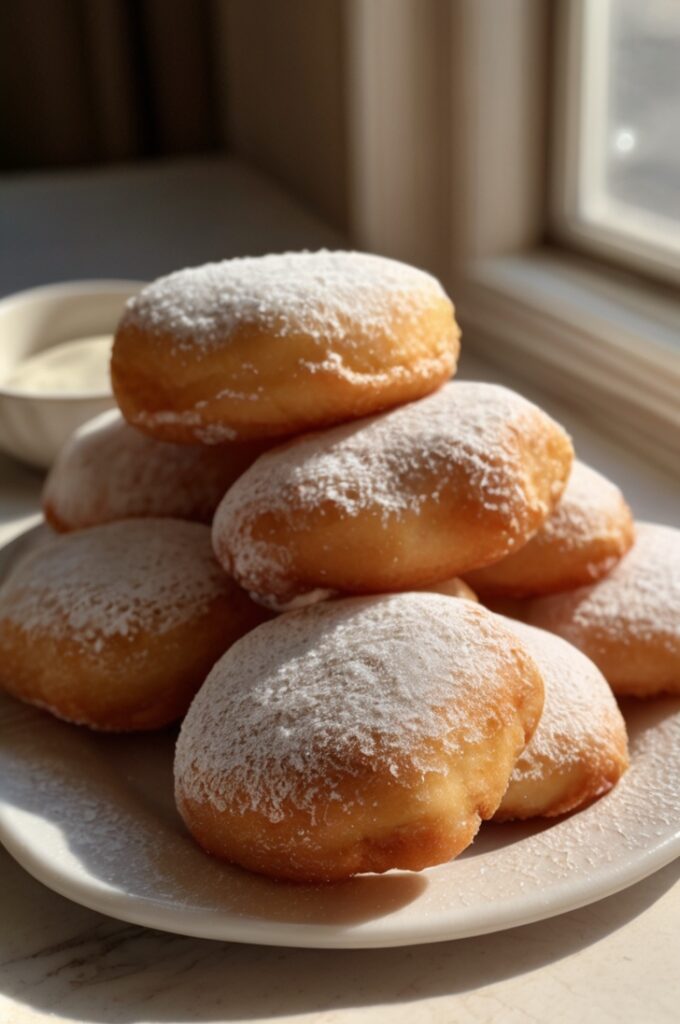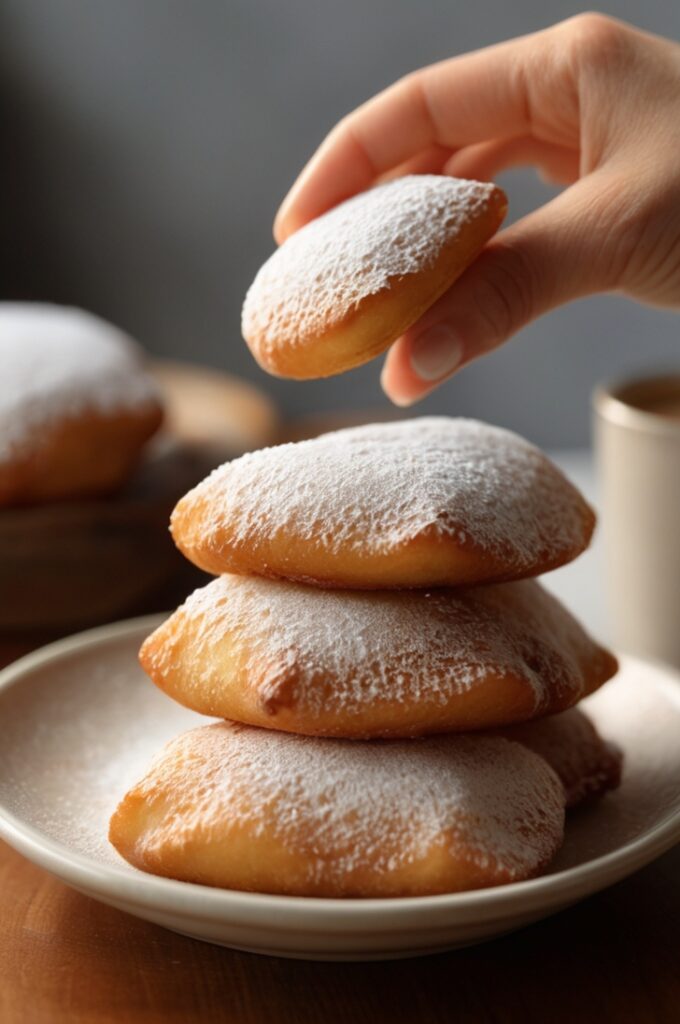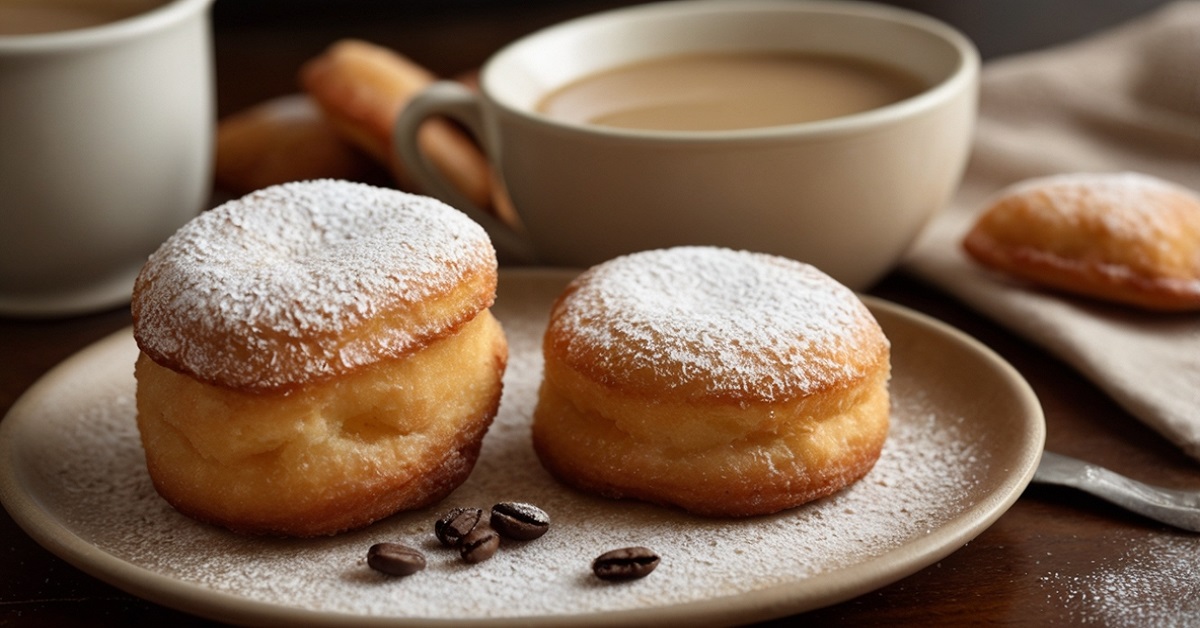Irresistible Vanilla French Beignets I swear, the first time I had a real one hot, crisp, and just barely holding it together under a snowstorm of powdered sugar I genuinely teared up. Not from the heat. From the memory it hit me with. It was Paris in the fall, street musicians groaning out brass in the distance, and I was sitting on a bench eating clouds. Clouds that crunched. That moment’s never left me. And I’ve been chasing that beignet ever since.
Let’s get one thing straight right off the bat these ain’t your funnel cakes. We’re not talking doughnut shop cake bombs either. French beignets, especially the vanilla ones we’re diving into today, are delicate and rich. They’ve got soul. They puff up like little pillows of joy, crackle with golden-brown crispness, and vanish in your mouth like they were never real to begin with.
So what makes these vanilla French beignets special? It’s the dough. Enriched. It’s the vanilla real vanilla. It’s technique. This isn’t a quick-mix-and-go situation. But it’s not hard either. If you know where to look, you’ll feel the dough tell you when it’s ready. That’s what I’m here for.
Ingredients & Substitutions

Here’s what you’ll need:
- 3 ½ cups (440g) bread flour (yes, bread not all-purpose)
- 2 tsp instant yeast
- ½ cup whole milk, warm (around 100°F)
- ¼ cup granulated sugar
- 2 large eggs, room temp
- 1 tsp kosher salt
- 1 tbsp vanilla bean paste (or pure vanilla extract)
- ½ tsp ground nutmeg (freshly grated is ideal)
- 6 tbsp unsalted butter, softened
- Neutral oil, for frying (canola or grapeseed work best)
- Powdered sugar, for dusting
Substitutions? Gotcha:
No bread flour? Use all-purpose but reduce liquid just a touch. You’ll lose a bit of chew, but it’ll still puff fine.
Can’t find vanilla bean paste? Use extract, sure. But add a little extra maybe 1½ tsp and toss in the seeds from half a pod if you’re feelin’ fancy.
Lactose-free? Sub in oat milk and dairy-free butter. It’ll still fly.
Egg allergy? Try a flaxseed egg, but just a heads up texture softens a bit.
Step-by-Step Instructions

1. Activate the yeast.
Warm your milk not hot, not tepid. Think bathwater for a baby. Mix with a pinch of sugar and sprinkle in the yeast. Let it sit for 10 minutes till it’s foamy like cappuccino top. If nothing happens, your yeast’s dead. Start over. Seriously.
2. Mix the dough.
In a stand mixer bowl, combine flour, sugar, nutmeg, and salt. Add your yeasty milk, eggs, and that glorious vanilla. Start mixing on low. Once it starts pulling together, toss in the butter bit by bit.
Chef’s tip: Dough’s gonna look wet and messy at first. That’s normal. Don’t panic. Don’t add flour. Let the mixer knead it out it takes about 8–10 mins.
3. First rise.
Shape it into a smooth ball. Pop it in a greased bowl. Cover tight. Let it rise in a warm-ish spot for 1½ to 2 hours. It should double. Or almost double. Dough is moody.
4. Roll & cut.
Lightly flour your work surface. Pat (don’t punch) the dough down, then roll it to about ½ inch thick. Cut into squares, 2 inches or so. You’ll get about 16–20.
Tip here: Don’t twist the cutter or knife. Clean cuts help ’em puff right.
5. Second proof.
Lay ‘em on parchment, loosely covered, for 30–40 minutes. Don’t skip this. That puff needs time to dream.
6. Fry time.
Heat your oil to 350°F. No eyeballing it get a thermometer. Slide in 2–3 beignets at a time. Fry each side 1–2 mins till golden brown.
Watch for: Too dark, your oil’s too hot. Too greasy, it’s too cold. You’ll find your groove.
7. Dust & serve.
Drain ‘em quick. While still hot, toss with powdered sugar like there’s no tomorrow. They should look like little sugar-dusted clouds.
Cooking Techniques & Science
Why bread flour?
It’s got more protein. More protein = stronger gluten = better puff. It helps trap steam so that you get that light, hollow belly inside.
Why soft butter, added last?
Classic brioche-style technique. Too early and it’ll coat your flour and block gluten development. Add it once the dough has muscle. You’ll get stretch, not stick.
Proofing matters.
Underproofed beignets stay tight and dense. Overproofed collapse like sad balloons. What you want is that sweet spot where they jiggle a little if you nudge ‘em.
Oil temp = success.
350°F is the goldilocks zone. Too hot, they brown before they cook inside. Too cool, they soak oil like sponges. Monitor constantly.
Science of puff:
Beignets don’t rely on baking powder or soda. It’s all steam and yeast. Steam expands rapidly when it hits hot oil, puffing the dough into those perfect airy pillows.
Serving & Pairing Suggestions

Fresh is best. Eat ‘em warm, ideally within 30 minutes. After that, they start thinking about going stale. No hard feelings.
Dust heavily with powdered sugar. Or go rogue cinnamon sugar, maybe a touch of cardamom. Or dunk in a warm vanilla anglaise or spiked chocolate sauce if you’re feelin’ extra.
Pair with café au lait. That classic New Orleans thing? They were onto something. You want the bitterness to balance the sweet.
For a savory twist, leave out the sugar in the dough. Add herbs and grated Gruyère. Serve with a garlic aioli. Yeah, I said it.
FAQs About Irresistible Vanilla French Beignets
1. Can I make beignet dough ahead of time?
Yes. After the first rise, cover and chill the dough up to 24 hours. Bring to room temp before rolling and proofing.
2. Do I really need a thermometer for frying?
Absolutely. Oil temp matters more than most think. It’s the line between pillowy and greasy.
3. What’s the best oil for frying beignets?
Neutral, high-smoke-point oils like canola, sunflower, or grapeseed. Avoid olive oil it’ll smoke and add the wrong flavor.
4. Can I bake them instead of frying?
Technically? Yes. But don’t. You’ll get something closer to a soft bun. It ain’t the same magic.
5. How long do beignets last?
Best eaten fresh. That said, you can revive them briefly in a hot oven (375°F for 3–5 mins). Still, nothing beats day-of.
Want to make memories stick to your teeth like powdered sugar? This recipe’s how. They’re humble. They’re messy. They’re perfect.
And once you make a batch, good luck keeping them on the plate.
Conclusion
Vanilla French beignets aren’t just another fried dough. They’re a ritual. A quiet moment in powdered sugar. A reminder that real joy is usually fleeting and fried.
They’re technical, sure, but not impossible. Respect the dough. Know your oil. Listen to your yeast. You’ll be alright.
Once you’ve made ‘em once, you’ll chase that memory again and again. Trust me. Beignets don’t just feed people. They haunt ‘em.




